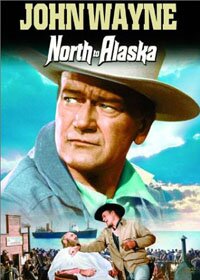There are certain movies I can make a reference to and people immediately know the film and usually recall it with a smile — if not outright laughter. Dirty Rotten Scoundrels is one of those movies. It didn’t change the world of movie making when it came out and didn’t win any awards. It simply did what most movies hope to do: get seen, be appreciated and remembered.
John Wayne heads north – booze and brawls ensue
 Directed by Henry Hathaway
Directed by Henry Hathaway
This movie, North to Alaska, is a difficult one to account for. I really like it a lot. But I can’t think of a single cinematic merit it has going for it. Essentially, if you don’t like John Wayne’s later movies, especially the comic ones, you won’t likely take to this film. In fact, you may take a strong dislike to it because it’s corny and wildly sentimental. But if you do like John Wayne …
From something I read somewhere on the Web (does it get more definitive or authoritative?), North to Alaska was one of the first, if not the first movie of John Wayne’s later career, the older Duke, as far as his comic films go. Later, there would be films like, Hatari!, Donovan’s Reef (his last with John Ford) and McLintock!.
In this movie, Wayne is teamed with Stuart Granger. They’re Sam (Wayne) and George (Granger), two guys who strike gold in Alaska. Both are elated, George so much so he sends Sam to Seattle to bring back his fiancé, Jennie. Unfortunately, in Seattle Sam discovers she’s already married. She wasn’t nearly as serious about the engagement as George was. Sam, determined not to see his friend disappointed, brings back a saloon dancer instead, Capucine (Michelle Bonet).
There are, of course, complications. For instance, Sam and Capucine fall in love, complicating Sam’s determination to take care of his friend. And there’s Frankie Canon (Ernie Kovacs), a scoundrel looking for ways of cheating Sam and George out of their claim.
In the middle of all this there is a good deal of brawling between the boys of the Alaskan town (including Sam and George), as well as romantic gamesmanship between Sam and Capucine.
In the end, it’s romantic fantasy – an Alaska that didn’t exist (except in the most broadly interpreted sense) and a feisty and unlikely romance. But realism wasn’t what they were going for. It’s intended as escapist entertainment. So you never see the reality of brawling like that or of drinking that way.
On that basis, it’s a fairly engaging film and pretty well succeeds at what it aims to do. It may come across as somewhat anachronistic to anyone who didn’t grow up with John Wayne movies. The sensibility is definitely not contemporary.
If this was the first of the later John Wayne comic films, it’s easy to see the template established: a bit of “battle of the sexes” romance, a lot of phony-baloney brawling and a good deal of drinking that appears to have only brief ill-effects, and only if the plot calls for it.
It’s fantasy but it’s fun. Movies like this are really about giving the audience the John Wayne they expect, in situations that underline the image, and doing it in a light-hearted way. In a way, it’s a bit like teasing a beloved friend or relative.
Yes, I think that’s what I’d say these movies are: light-hearted teasing of the John Wayne image that underscores just how beloved he was.
2½ stars out of 4.


